Sony A90J Reviewed at $2,799.00 (55")
Product Name: Sony A90J
Product Description: 2021 4K UHD OLED TV
-
Design - 9.1/10
9.1/10
-
Video Quality - 9.2/10
9.2/10
-
Ports & Connectivity - 9/10
9/10
-
OS, Apps and Features - 9.2/10
9.2/10
-
Price / Quality - 8.6/10
8.6/10
Summary
Reviewed at $2,799.00 (55″)
Pros
- Amazing black levels
- Most impactful HDR brightness
- Great color performance
- Fully packed with features
Cons
- No VRR available yet
- There was visible judder
- No HDR10+
- Very expensive
Cheapest Places to Buy :
*We are a reader-supported website. When you buy through links on our site, we may earn a small affiliate commission at no extra cost to you. Home Media Entertainment does not accept money for reviews.*
Not too long ago we had the pleasure of checking on of Sony‘s new OLED TVs. But the real interest was in Sony’s top OLED flagship that for the first time would be using the improved OLED panel in order to help push more brightness than conventional OLED panels could do until now. So in our Sony A90J review today we will be looking into this top premium release and if it is really worth the extra cost for what you get.
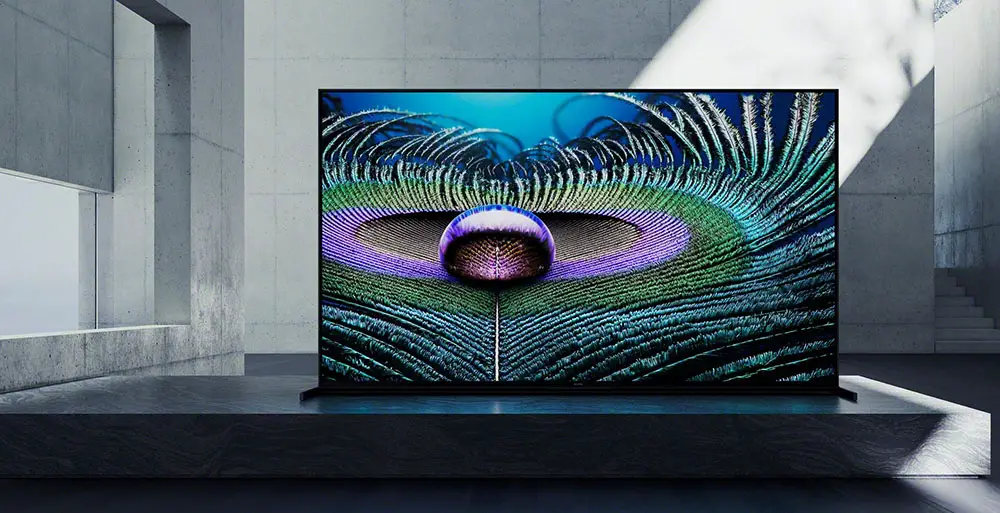
If you look at the specs the A90J is not all that different from the other Master Series OLED, the Sony A80J, By the way you can check our review and take on that one in the link. The two OLEDs from Sony share an awful lot of features and any differences there are, have to do mainly with the addition of the new improved OLED panel and everything this brings. So in essence you can say that the A90J is a beefed up A80J which can only be a good thing as the A80J is a really excellent release and one that certainly many consumers will choose for their entertainment.
But let’s see what the A90J brings to the table. It uses a new improved 100/120Hz OLED panel in combination with a heatsink in order to dissipate the heat faster, features the new Cognitive Processor XR and uses Sony’s most advanced Acoustic Surface Audio+ system. There is Dolby Atmos and Dolby Vision support, comes with two HDMI 2.1 ports along with all its gaming centric features, although VRR is still a promised one, and is packed with the new Google TV platform that includes a huge list of streaming services, Chromecast, Airplay 2 and Homekit, the new Bravia Core streaming service, voice control and many more like Netflix calibrated mode, IMAX Enhanced and Calman Ready.
On paper it looks like an excellent unit. Everything the A80J had along with the new panel surely is a recipe for success. But with the increased price is the A90J still a worthy purchase? Let’s find out…
Design
Overall the A90J is following the same design principles we have seen in most OLED TVs. An extremely thin panel is accompanied by a thicker plastic box where all the electronics are grouped together. Borders are thin enough to make the actual screen look more immersive while overall thickness was measured at 1.6″ (4.1 cm) which actually makes the A90J thinner than the A80J. With such a thickness the TV will surely look absolutely great on a wall. And since we mentioned wall mounting all ports are either looking sideways on downwards, as per usual with most Sony TVs, making them easier to reach when on a wall.
With both the A90J and A80J belong in the same series and having so similar characteristics one would expect them to have a similar back panel. But this isn’t true as the design of the A90J is completely different. This may have to do with the fact that the A90J includes a heatsink so it actually needed a redesign of the back panel to incorporate it. Layout is still pretty much the same with all the ports being grouped together on the right side and only the power connector is on the left side inside a special inset. Not much else is visible, Sony’s OLEDs are a bit weak when it comes to including some short of cable management, with only the VESA holes present in the middle for using a wall mount.
Sony has rethought the design of their TV stands and as we saw it the A80J the one we get in the A90J can be used in different positions depending your needs. To do that Sony had to use the bench type of stand with two legs placed almost at the far edge of each side. Now the available positions in the A90J are two. You can either place them flat which brings the TV almost touching the surface it is placed on and there is also the elevated position if you have a soundbar to place underneath. There is a third narrow position but this seems to be available only in the 83″ and was not available in the 55″ size we have here for testing.
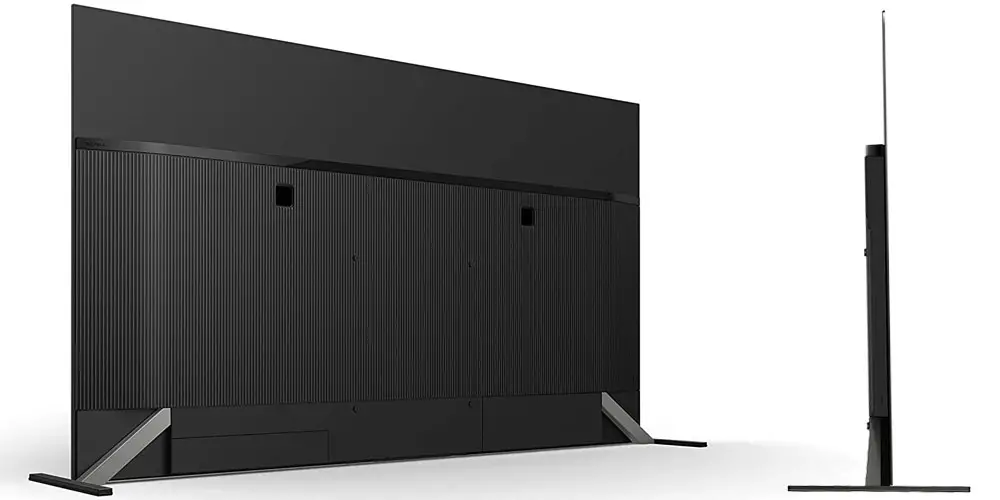
When it comes to their remotes Sony was always playing catch up compared to Samsung and LG. And this was a major complaint we had as even some of their higher tier offerings were using atrocious and old style looking remotes which was unacceptable. Last year Sony finally decided to fix that by redesigning the whole thing and at least now you get a remote that looks far better and has a more premium feel compared to the cheap remotes we were getting before.
The only difference we see this year is instead of only two dedicated buttons for Google Play and Netflix now we have four and these are used for Youtube, Netflix, Disney+ and Amazon Prime video. There is also a Google Assistant button that can be used with the built-in microphone in order to issue your voice commands but in order for that to work it needs to be paired to the TV through Bluetooth. If you pair it then all other commands work without the need for line of sight which is a nice small feature to have.
Everything else is exactly the same and all buttons have a nice feel to them with certain distance from each other to avoid pressing the wrong one. The only difference this remote has compared to the one we saw in the A80J is that this one comes in a silver color and uses motion detecting backlight which the A80J one didn’t have. Motion detecting backlight is the best you can get in a remote as you don’t have to push a button for the remote to light up and it can be a huge convenience once you get used to it. Personally I really loved it!
The A90J surely looks like a premium TV. Nice and thin design, multiple stand placement options and a great remote is what Sony’s top flagship should be.

Video Quality
Processor technology used
Sony didn’t have any mini LED TVs to demonstrate this year so most of their marketing attention turned into the company’s new silicone named Cognitive Processor XR. Sony included their new chip in all their mid and high-tier units this year so the A90J obviously would be using Sony’s 2021 finest.
The new chip divides the screen into hundreds of zones and recognizes individual objects in these zones better than ever before. What’s more, it can cross-analyze around a few hundred thousand different elements that make up a picture in a second like focal points, contrast, colors, motion and clarity and determine ways in order to improve the end result even more.
The only difference we find in the A90J compared to the A80J is that in the included suite of the A90J we get the XR Contrast Pro instead of the simpler XR Contrast on the A80J. Everything else seems to be exactly the same.
The new processor is not only good at providing excellent picture quality but also deals with all sound elements. Being included in the XR Sound suite the processor supports XR Sound Position in order for the audio to match exactly what is displayed on screen while XR Surround is responsible for creating a virtual 3D environment in order to up the immersion even more. But we will talk more about the audio in our dedicated section.
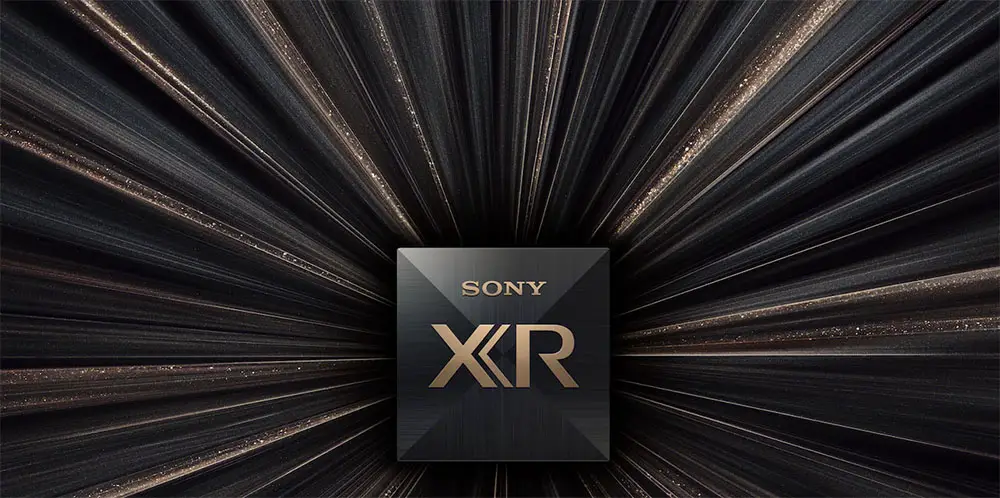
Lighting technology used
The A90J, as with all the other OLED models, is using self emitting pixels and don’t have a need for a backlight as LCD TVs have. This results in higher light control and precision, and the ability to turn off completely its pixels means that you can get totally black levels which is really as good as it gets and really elevates the image quality tenfold compared to what we see in most LED LCD panels.
Because there is no backlight the A90J has no problems like blooming that creates bright halos around bright objects when seen in dark backgrounds and also its image quality is not dependent on how many zones the backlight has as all FALD LCD TVs do. So in this regard all OLED panels behave the same.
But as with everything OLED has a few shortcomings. The first one is that all OLED TVs, due to the technology involved, cannot be as bright as LCD TVs can. In the early years there were small advancements in this but the last few yearly releases seem to have hit a wall.
Panasonic was the first to find a solution to this a couple of years ago with the introduction of a heatsink that would allow the new, more efficient panel to be pushed more than before and in 2021 Sony also used the same technology in their flagship A90J OLED. The A80J is not using this technology and is meant more as a mid-tier OLED but the A90J we have here is and the inclusion of the more efficient OLED panel along with a heatsink to dissipate the excessive heat faster can help the TV push its brightness just a bit more than ever before.
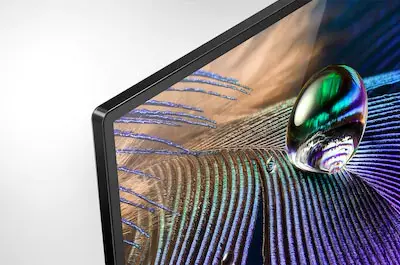
Another characteristic that is the result of using the new OLED panel is that the A90J seems to be able to clear image retention just a bit faster than what the A80J was capable of. Though in normal use this will mostly go unnoticed by using some special patterns and measuring the time they needed to disappear the A90J measured faster than its smaller brother.
Another shortcoming is that OLED technology is more prone to permanent burn-in. We have seen manufacturers adding special features to combat this but nevertheless OLED has slightly increased risk of burn-in due to the use of organic materials and should be handled with care. Unfortunately Sony is not implementing some advanced techniques that dim specific parts of the screen as some other manufacturers do and rely on dimming the whole screen for that same reason.
Brightness / Contrast
Starting our measurement tests we begin as always with brightness. By using the Custom Picture mode and with maximum brightness the unit gave us 495 nits of brightness in our 10% white window SDR brightness test over a dark background. This is more than enough for any kind of SDR material so no real surprises here. Keep in mind that this value was achieved with Peak Luminance set to high otherwise the brightness output is vastly different.
On our 10% white window HDR test now the A90J was able to output 815 nits of peak brightness. Again we used the Custom Picture mode with maximum brightness and although the TV cannot reach brightness levels as some of the top LCD TVs it definitely is one of the brightest OLEDs you can find right now.
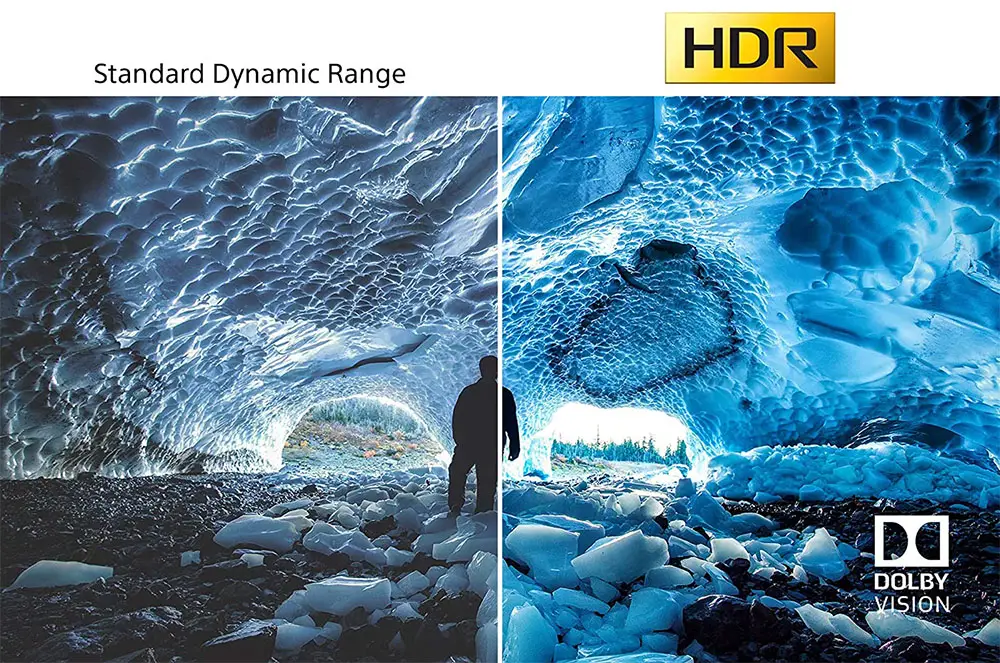
Keep in mind that the TV can go a bit higher with these numbers by using the Vivid Picture mode in combination with a few other settings available but you are going to loose some picture accuracy so it’s a tradeoff really and depends on what you prefer the most. Also its aggressive ABL will result in very different brightness levels in real world scenarios as it depends on how bright the panel gets across the entire screen.
What we observed from our tests was that the A90J was overall slightly brighter than the A80J but if you can see this difference or not depends on the content at hand. Small highlights will appear slightly brighter while scenes that are filmed in broad daylight may seems slightly punchier. To be honest in order to understand the difference you have to look at them side by side and only because we had a A80J at hand we were able to truly see these differences. Otherwise it’s not easy to tell them apart.
As for contrast having an OLED panel means that the A90J can switch off it’s pixels entirely meaning it gains almost infinite contrast ratio resulting in true deep blacks compared to greyish blacks we see in many LCD models while it’s panel uniformity was also very good from what we saw.
One thing we should mention is about permanent image retention which is a hot topic among OLED fans. For this we recommend to turn on Pixel Shift from the TV settings and run Panel Refresh as frequently as Sony suggests. Also keep in mind that long gaming or broadcasting sessions can make certain logos or static graphics to burn-in but since this is not to a certain thing you should always change the image every few hours just to be on the safe side.

Another characteristic of the A90J, that we briefly mentioned above, was the fact that due to the included heatsink the A90J was able to clear image retention faster than the A80J. Obviously the risk of permanent burn-in is still there but the fact remains that for fast transitions of bright images the A90J is capable at clearing its image slightly faster.
Viewing angles
Viewing angles was always one of the strongest points of any OLED and as such the A90J could not be any different. OLED is the best technology in this regard and no matter what kind of advancements they have done, LED LCD technology will never get as good in this.
As such the A90J behave very similarly as other OLED panels both from Sony and other competing OLED brands. This means that even at angles that reach about 45-50 degrees colors, black levels, brightness and contrast seem to hold up really well with no major degradation. Obviously anything more and the image quality starts to deteriorate but no one would be watching at such extreme angles anyway.
If you want to use this TV for all family with many members watching at different angles then the A90J is ideal for that kind of use.
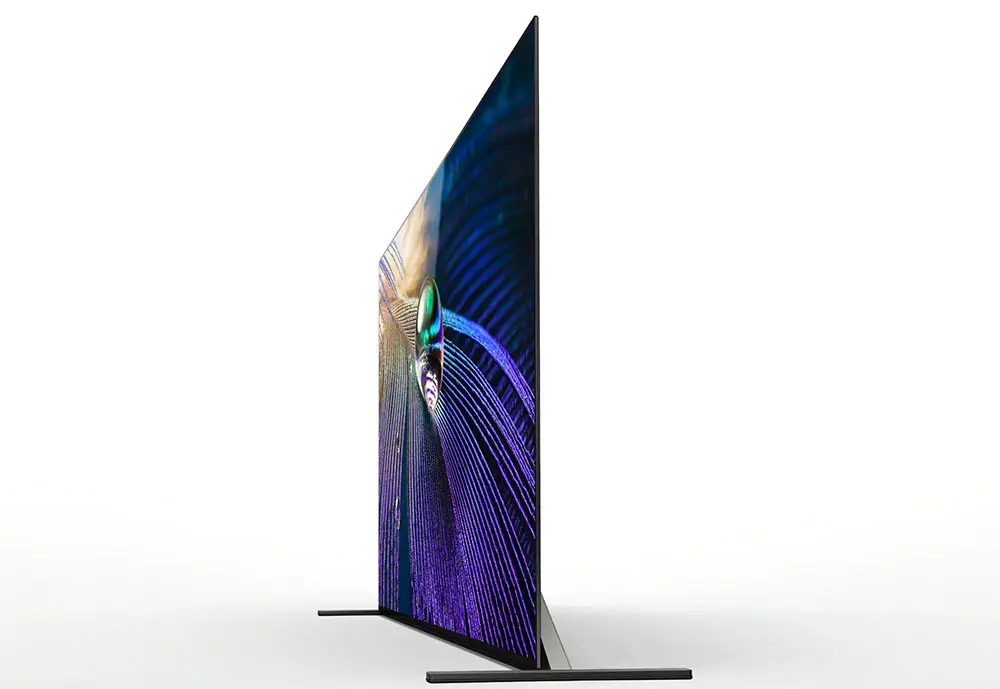
HDR support
The A90J supports three HDR protocols at the moment with the basic HDR10 that is required for UHD playback, HLG that is used in broadcasting and streaming media as well as Dolby Vision that is a more advanced protocol that uses dynamic metadata for more accurate and better image quality. As with all Sony models in 2021 there is no HDR10+, which is similar to Dolby Vision but it doesn’t have the support Dolby’s solution have yet and Sony doesn’t seem very eager to support it.
Also keep in mind that there is no Dolby Vision IQ which we have seen in some other 2021 Dolby Vision enabled TVs which uses the TV’s light sensor in order to adjust the Dolby Vision tone mapping dynamically without altering the colors. None of the two Sony OLEDs have this in case you were wondering.
Color coverage
The A90J, as with the lower tier A80J, is equipped with certain technologies in order to allow it to display deeper and more lifelike colors. As such Sony has used a XR Triluminos Pro display which we have seen in many of their higher tier models this year along with XR Color technology which is included in their XR Picture suite.
As for the A90J specifically we measured 98% coverage in the DCI-P3 color space which is almost perfect. On the wider REC.2020 color space we got a 72% coverage which is also very good.
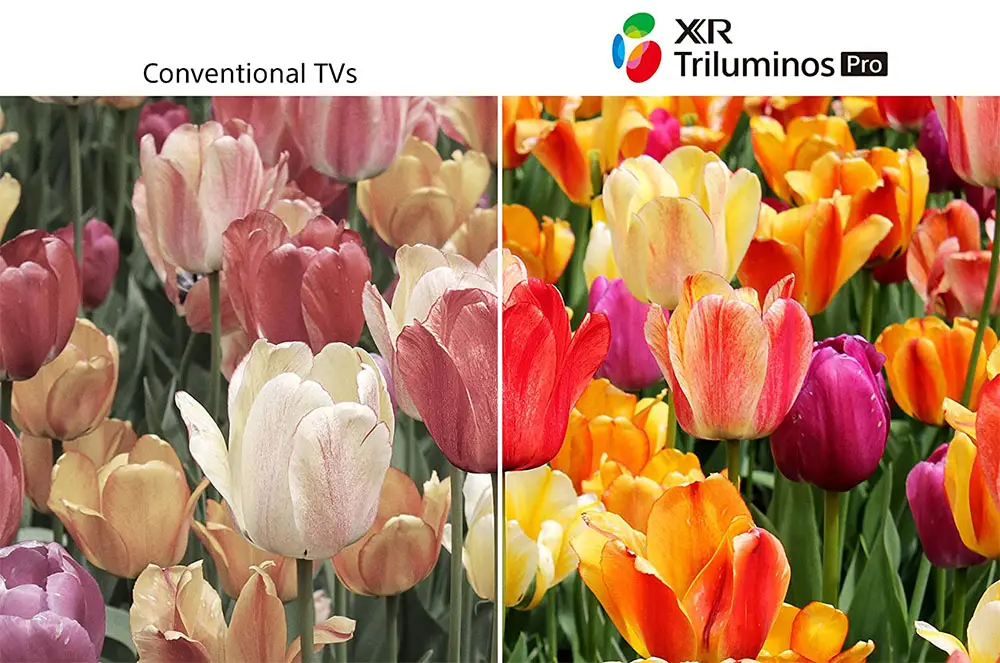
The A90J performed almost the same here as the A80J and shows how similar both TVs are in terms of color reproduction since they basically use the same tech. As for color gradients the A90J handled them superbly although we did notice a bit of banding on some grey colors but nothing to be overall bothering. A Smooth Gradation option is available that can improve this but in doing so you are going to loose some image details so it’s a tradeoff to be honest.
Motion performance
Once again the A90J uses exactly the same feature set and capabilities that were present in the A80J. The TV comes with a 100/120Hz panel (depending on your region) while due to the inclusion of Sony’s new processor we get XR Motion Clarity which is the latest technology used to smooth out motion.
You have the option to use either the standard motion interpolation system or use the Black Frame Insertion (BFI) interpolation that is adding black frames in between individual frames and can potentially smooth out motion. BFI can be enabled by turning Clearness to an appropriate value if you use the Custom setting in the MotionFlow menu. Overall with motion interpolation enabled things looked pretty good although we still saw a few artifacts here and there in very hectic action scenes. At least they were not to such an extent as we had seen in the X80J and X90J reviews. And keep in mind that in general BFI has also a negative effect on brightness due to the black frames that are inserted.
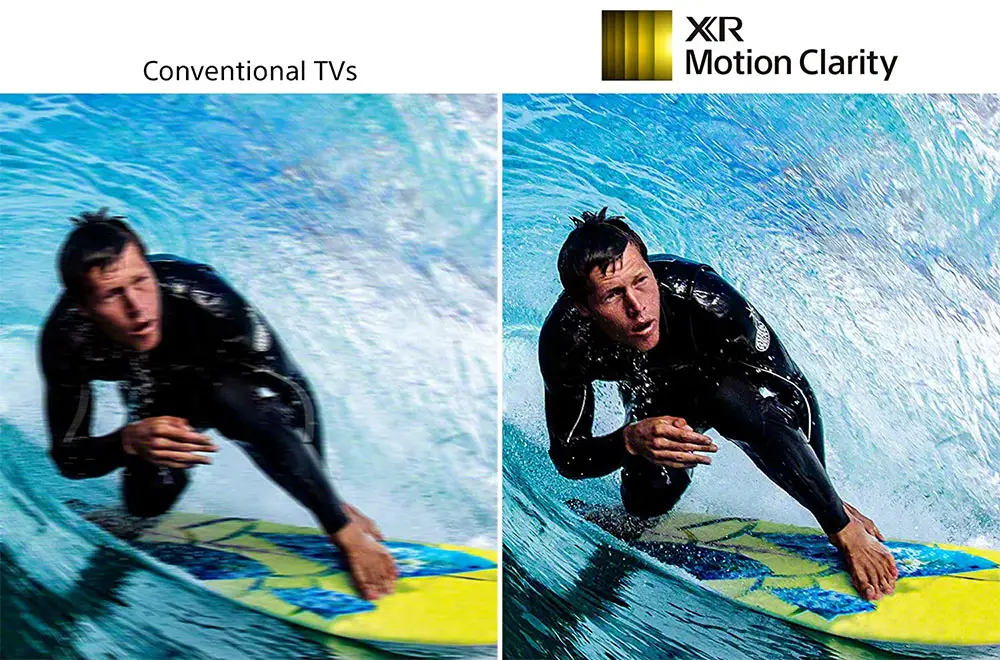
Now we need to mention something that is haunting Sony for some time now. The A90J will support VRR that will come in a future update but is not currently available. When this will arrive is unknown and judging by their promises we would suggest you to decide with what features are available right now and not what is promised in the future with an unknown release date. VRR seems to have been a troubled feature for Sony for some time now and we don’t really know how long it will take for them to implement it. So we would suggest you not to hold your breath for it.
The A90J was ok overall but we did notice some bothering judder in certain scenes which can detract from the overall very good quality of the image. The problem was not noticeable all the time and we had to playback certain scenes many times to be sure but the fact is that motion on the A90J is not as good as you would expect from such a top tier flagship. And if you are not very fond of using the motion interpolation features available to combat stuttering and judder then this is something you have to consider before buying this one.
Input lag
Next we have our input lag tests and here we don’t expect any surprises as we are used to see low numbers in most recent releases from all manufacturers.
And so with Game mode enabled we managed to get an average between 1080p and 4K resolutions of 16.9ms which is very good and right where we were expecting it. With Game mode turned off input lag will rise to about 148ms which is still ok for casual gaming but certainly not for more demanding gamers.
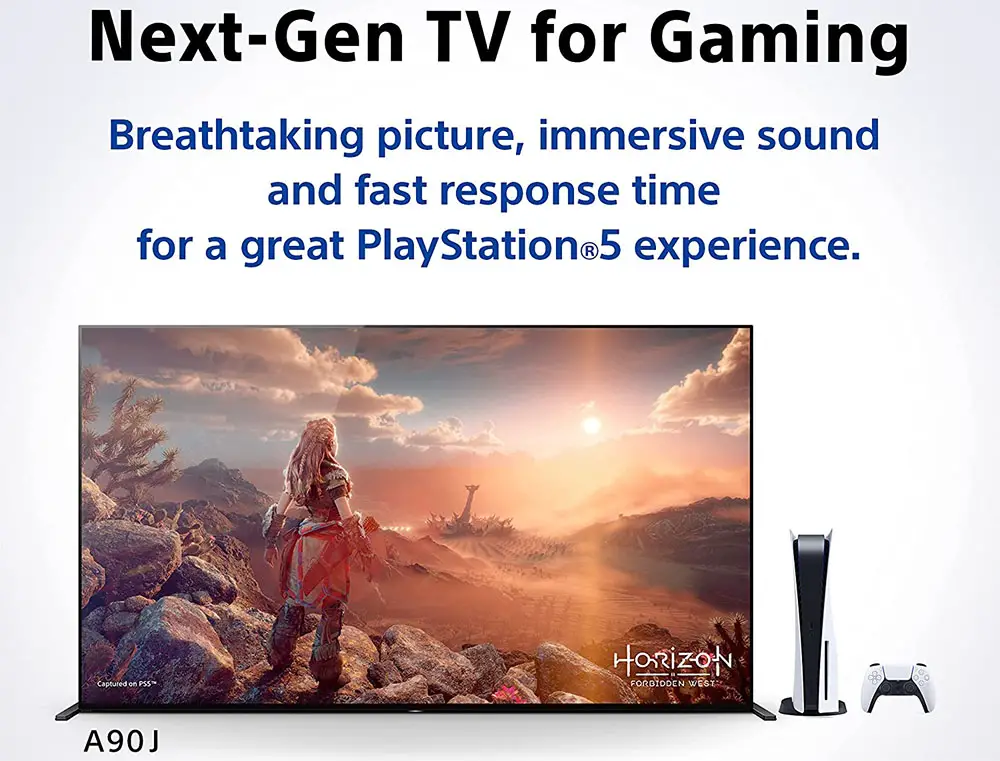
With the inclusion of HDMI 2.1 the unit comes with all the game centric features this offers including Auto Low Latency Mode (ALLM) which can really benefit the new game consoles that support it.
For some real world testing we used our PS5 with a copy of F1 2021. PS5 does not yet support VRR so we were not missing anything on that front. With the Game mode enabled we got super fast response times and really we had a very smooth session. No delays or anything that could potential mean trouble either you are a casual or a hardcore gamer. Hopefully we will get VRR at some point in order to satisfy those that want that but until then the A90J should still be considered a good gaming TV.
Image quality impressions
The A90J is an impressive TV no matter how you see it. Yes it may not be the brightest of TVs as LCD TVs still have the upper hand here but if you take into consideration that it’s the brightest of OLEDs along with all the advantages this technology has then what you get is one of the best performing TVs of 2021.
HDR was very good, viewing angles are excellent as with all OLEDs, color reproduction and gradients were great and input lag was good even for the most demanding of players. Add to that the Netflix Calibrated mode, IMAX Enhanced support and Calman Ready for the more advanced users and you don’t really miss anything here.

On the downsides motion performance was once again so and so with the A90J displaying some obvious judder. VRR is still missing in action while Sony refuses to include HDR10+. Lastly as with all OLEDs there is a slightly increase risk of burn-in.
Audio Quality
Next is the sound and what we have here is exactly the same setup we saw in the A80J. The TV uses what Sony calls Acoustic Surface Audio+ technology which basically uses two actuators at the back of the panel that vibrate and use the whole panel as a huge membrane and thus create sound. This way it seems like audio is coming from within the screen giving you a better sense of realism. This type of audio system is used by Sony the last few years in their top tier units and in 2021 it seems that only the two OLED releases come with it, the A80J and the A90J.
The TV is using two actuators along with two subwoofers and come with a 20W + 20W + 10W + 10W power output configuration. There is support for Dolby Audio, Dolby Atmos and DTS Digital Surround sound but as with all these TVs surround immersion lacks a lot compared to a true surround system. Also keep in mind that Sony is one of the few companies that still supports DTS and can even pass-through both Dolby Atmos and DTS:X signals from its eARC port so if this is important to you then the Sony is a no brainer.
The inclusion of the XR cognitive processor has allowed the A90J to bring forth a few more advanced technologies which is the XR Sound suite. This includes the XR Sound position which with the help of the Acoustic Surface Audio+ technology makes sound originate from the exact spot on the screen making audio so much more realistic.
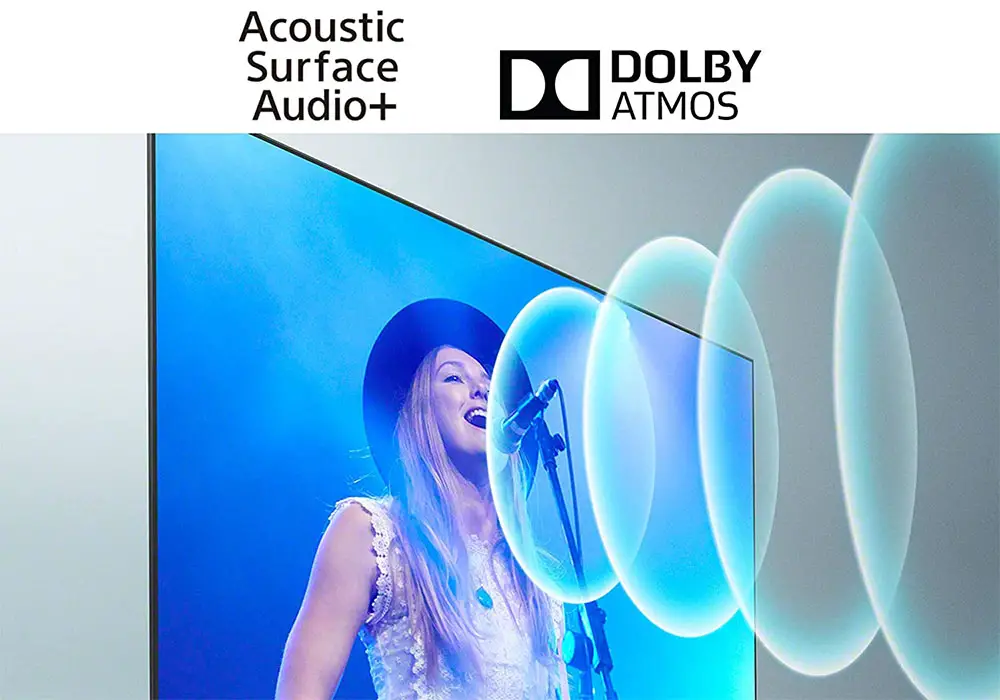
Also with XR Surround the A90J is using 3D surround upscaling in order to create a more immersive virtual surround environment. These virtual technologies are never as good as the real thing and even though the A90J do try to bring the action closer to your sitting position it is very dependent on the content and the type of action that determines its overall quality. The A90J also features Acoustic Auto calibration in order to get the best audio performance no matter your sitting position.
In all honesty the performance of the A90J was very similar to what we experienced in the A80J. It is good for casual use and certainly a cut above what typical 2.0 channels audio systems can do but in no way it can portray surround audio the way it is meant to. Without the use of actual surround speakers these TVs simply don’t have the means to produce surround sound. If you plan on buying such a premium TV then we strongly suggest you to at least get a good soundbar in order to get the most out of it. Such a TV really deserves at least that.
Ports and Connectivity
Next we will be looking at the available connection ports which in the A90J are separated into two groups with one looking sideways while the other is looking downwards. All of them are placed on the right side of the back panel.
Let’s talk about the ones looking sideways first. Sony has been using the same layout in many of their models so what we have here seems very familiar. At the top we find a Remote IR input, a composite video input, a headphones mini jack, two USB ports for connecting external storage or other USB devices and a single HDMI input. On the group looking downwards we get a third USB port, three more HDMI inputs, an RS-232C port, an optical audio output, an Ethernet port for wired connection to your local network and the usual antenna/cable port.
The A90J comes with two HDMI 2.1 ports along with two more older HDMI 2.0 ones. Although some other manufacturers like LG offer more HDMI 2.1 ports at least two are better than one. The problem here is that one of them is also the one with ARC/eARC functionality so if you plan on using that then you are left with a single HDMI 2.1 port.
Also keep in mind that, as we already mentioned above, while the new HDMI 2.1 ports bring with them all the new features like ALLM, VRR and HFR, VRR is not supported at release and Sony has promised a future update for that, although when this will be available is currently unknown.
Lastly one small difference we find in the A90J is the addition of a mic switch just under the sideways looking HDMI port that was not included in the A80J. The A90J has a built-in microphone so in case you don’t want this to be turned on all the time you can turn it off this way.
In terms of wireless capabilities things are pretty much the same across the board so the A90J comes with built-in WiFi (802.11ac) along with Bluetooth v4.2. A bit disappointing really for such a high profile TV when some other manufacturers already are using at latest Bluetooth 5.0.
OS, Apps and Features
In 2021 Sony decided to take things one step further as far as the smart TV platform they use is concerned. All their TVs now come with Google TV instead of Android TV that was being used until last year. There are no actual differences found in the A90J compared to what we had seen in the A80J before. All features are the same and performance was in general similar so this part of our review is going to be the same as before with appropriate changes whenever we deem necessary.
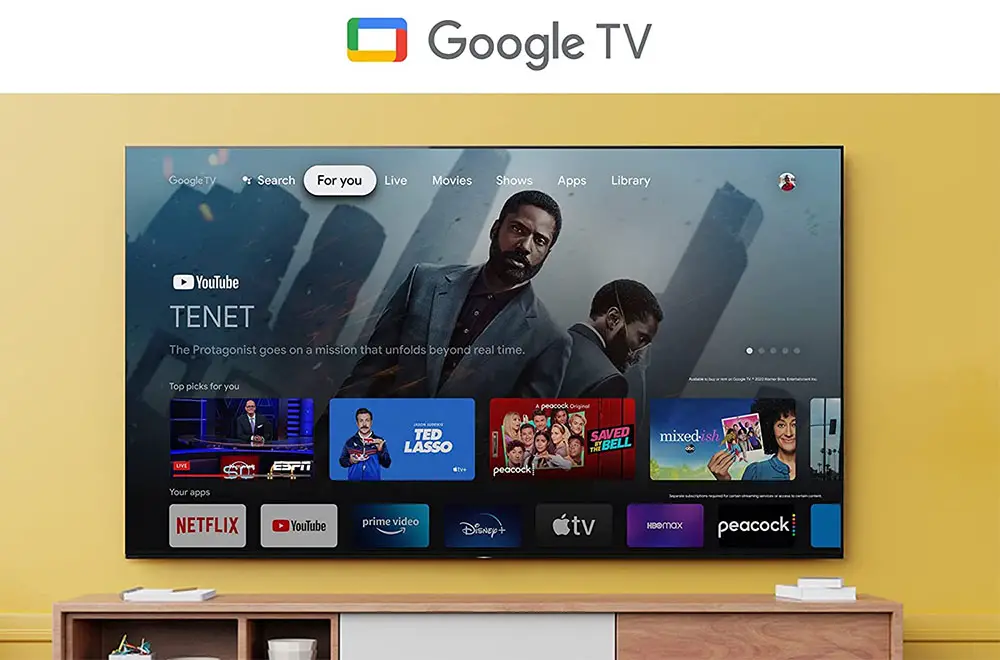
Now many of you may be puzzled what the difference between Android TV and Google TV is. Well, it’s not so much difficult to understand what has changed really. Google TV is still Android TV but with an extra layer on top of it. Think of it like it is in Android smartphones. Most manufacturers that use Android, on top of that they add their own layer that gives this extra something to their UI to make them unique both in appearance and functionality.
The same is with Google TV. You still basically use Android TV but there is the extra Google TV layer on top in order to make the UI feel different both in looks and functionality. The 2021 TVs from Sony that use Google TV have at their core the latest Android TV 10.0 but the home screen has been completely changed due to the new Google TV layer.
Everything now seems to have been designed around recommendations either it be movies, TV shows or applications and this seems to be the main focus of the new Google TV in general. During setup the wizard asks you of what specific streaming services you use in order to customize the Home screen recommendations. Keep in mind that Google TV is still Android at its core even though it looks different. But with Google TV things seem more fluent, more direct and more easy to navigate around.
If there is one thing that Android has in abundance that is huge app support. Through the included Google Play Store you can find literally thousands of apps that you can download and use except from the pre-installed ones. There is so much content available that you will definitely find the ones you are looking for and the list goes on and on.

All the big names are obviously present like Google TV, Disney+, Netflix, Amazon Video, Hulu and Youtube as well as Pandora, Tidal, Google Play Music, Spotify or iHeartRadio. As always some of them are region dependent so make sure the ones you are interested in are working in your area. Lastly certain apps like Netflix and Youtube support playback for both 4K and HDR content for those interested in it.
Here we need to mention that the A90J also comes with Netflix Calibrated Mode and what this does is to allow you to experience picture quality close to a filmmaker’s vision and intent for all content that is streamed through the Netflix streaming service.
The TV also comes with a new 2021 feature called Bravia Core and this is Sony’s online streaming service that promises high quality streams up to 80 Mbps and additional IMAX Enhanced content. With so many online streaming services we fail to see how Sony plans on making an impact with their own take on the online streaming world but since they can include it in all their TVs it will be interesting to see if this will expand in other manufacturers also in the future. Otherwise we don’t see this making a huge impact in an already oversaturated market in terms of companies trying to get a piece of this market.
Chromecast is also available here and it gives you the ability to stream content from other Chromecast enabled devices like mobile phones and tablets directly to the TV. Voice control is also present but it seems that it is a bit limited compared to other competing models. By that we mean that although you can use the remote’s built-in microphone to give commands to Google Assistant, for Amazon Alexa you will need an external Alexa enabled device to work. Additionally there is also Sony’s Voice Search available.

We have seen the same thing in many other Sony TVs and probably this has to do with the fact that it’s using Google’s Android system and thus having Alexa built-in was not possible. With voice control you can issue various commands to the TV but functionality extends far beyond that as you can control any smart devices you have in your house also.
There is also a built-in media player available that you can use to playback various video and audio content from an external storage connected to the USB ports. Sony’s built-in player was always a good performer and we can assure you that it will be able to play a wide range of files and codecs but in general don’t expect it to replace your dedicated media player box if you use one. If there is a file that is not following the usual standards it will not play it something that a dedicated player might will.
We did try a wide variety of files with different codecs and containers and most of the usual ones did play just fine. Only some more rare ones or some that had extremely high bitrates had trouble with the A90J.
Sony has also added support for both Apple Airplay 2 and HomeKit. With Airplay 2 you can stream content from other Apple devices on your TV while HomeKit lets you control certain aspects of the TV through your mobile device. Also if you are all Apple then keep in mind that the A90J supports Apple TV which is Apple’s online streaming service in order to have the complete Apple’s suite. So in case you favor Apple’s products the A90J will certainly cover you in this respect.
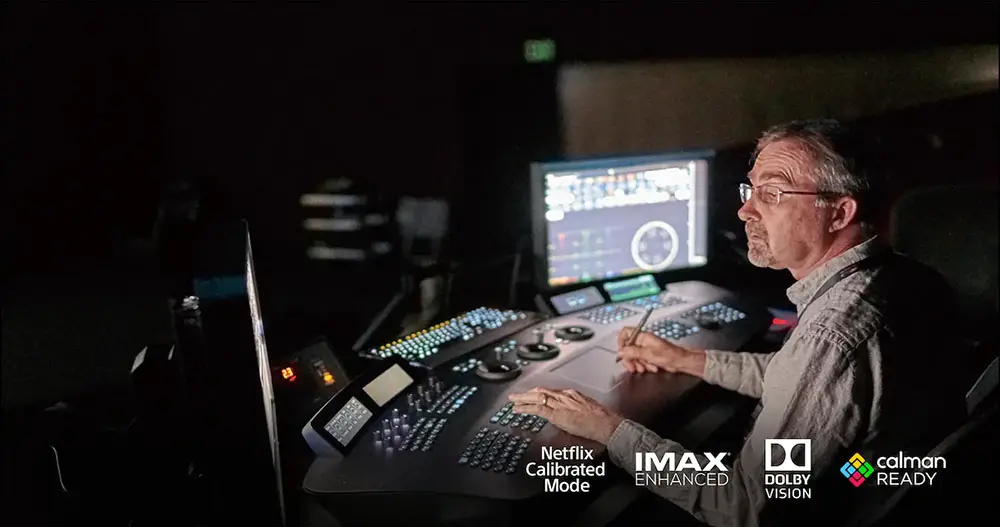
This year all Sony TVs are Calman Ready. To address color variations from the production process, the TV is ready to use Portrait Displays’ high-performance Calman auto-calibration software. This allows an unprecedented level of calibration and the ability to fine-tune adjustments simply not possible through conventional picture settings. It delivers high-fidelity color reproduction that’s true to the original TV signal, and can even adapt to the subtlest changes in color that may occur over time.
Also the A90J is one of the very few TVs that come with IMAX Enhanced certification. This means it can playback IMAX Enhanced content although this is still very scarce to find.
One last thing we need to mention is that there is no official app support for controlling the TV. If you want to control the A90J using your mobile device you can use the Android TV app made by Google that supports many of Sony’s TVs the last few years. It’s nothing major but can be a nice alternative to the included remote if you want to have more options.
The new Google TV is still Android at its core but Google has really changed it for the better. It feels more personalized, more streamlined and in general easier to handle. It still needs some getting used to it but after a while it will become a second nature.
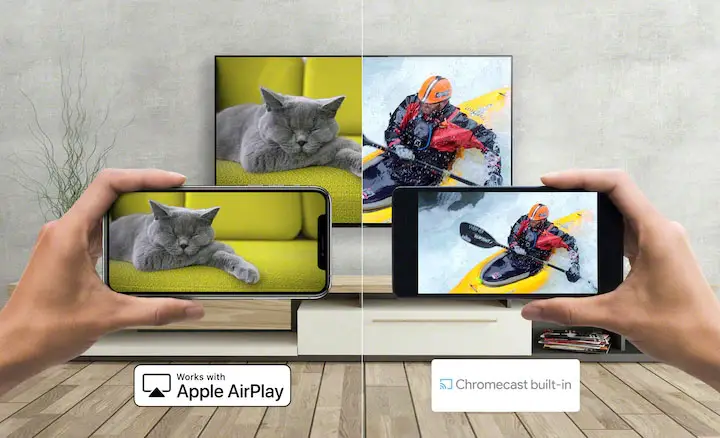
Final Thoughts
With the improved panel that the A90J comes with there comes the inevitable question if the slight increase in brightness would justify the extra cost compared to the A80J. Well, yes and no. The thing is that the A90J is undoubtedly the most impressive OLED TV to this day. It takes all the strengths of the OLED technology, add Sony’s excellent XR cognitive processing and spice things up with the slightly improved OLED panel that can really add this little something to make a difference.
If you are looking for the best OLED money can buy then sure, the A90J is the way to go no questions asked. But when we are talking value for money we would say that the extra cost is a bit too much for the very little improvement you are going to get. So in case you want an OLED but are also thinking about the cost then maybe the A80J is a better choice for you because their differences are really small.
To keep everything into perspective what the A90J offers more than the A80J is the new improved panel and heatsink along with OLED XR Contrast Pro, slightly faster image retention clearing and a motion-activated backlight remote. Oh and also the A90J is offered in a bigger size at 83″ compared to the 77″ of the A80J. Lastly, for whatever reason, the A90J seems to feature a slightly glossier anti-glare coating. Nothing else is really different between the two and it only depends on if you are willing to pay the extra cost to get this slight improvement or not.
On the downsides the A90J is more or less on the same boat as the A80J. Motion performance has a few problems, there is no VRR yet, Sony still refuses to support HDR10+ while as always burn-in is a factor to consider when talking about OLED technology.
The Sony A90J is an impressive TV no matter how you see it. If you can afford the extra cost then by all means go for it as there is nothing better out there to this day and will surely remain a memorable release until something better comes out in the future.

For more reviews you can check our dedicated 4K OLED TV reviews list or even look at our Product Reviews Table where you can find the brand and specific product you are looking for.
Cheapest Places to Buy :
*We are a reader-supported website. When you buy through links on our site, we may earn a small affiliate commission at no extra cost to you. Home Media Entertainment does not accept money for reviews.*
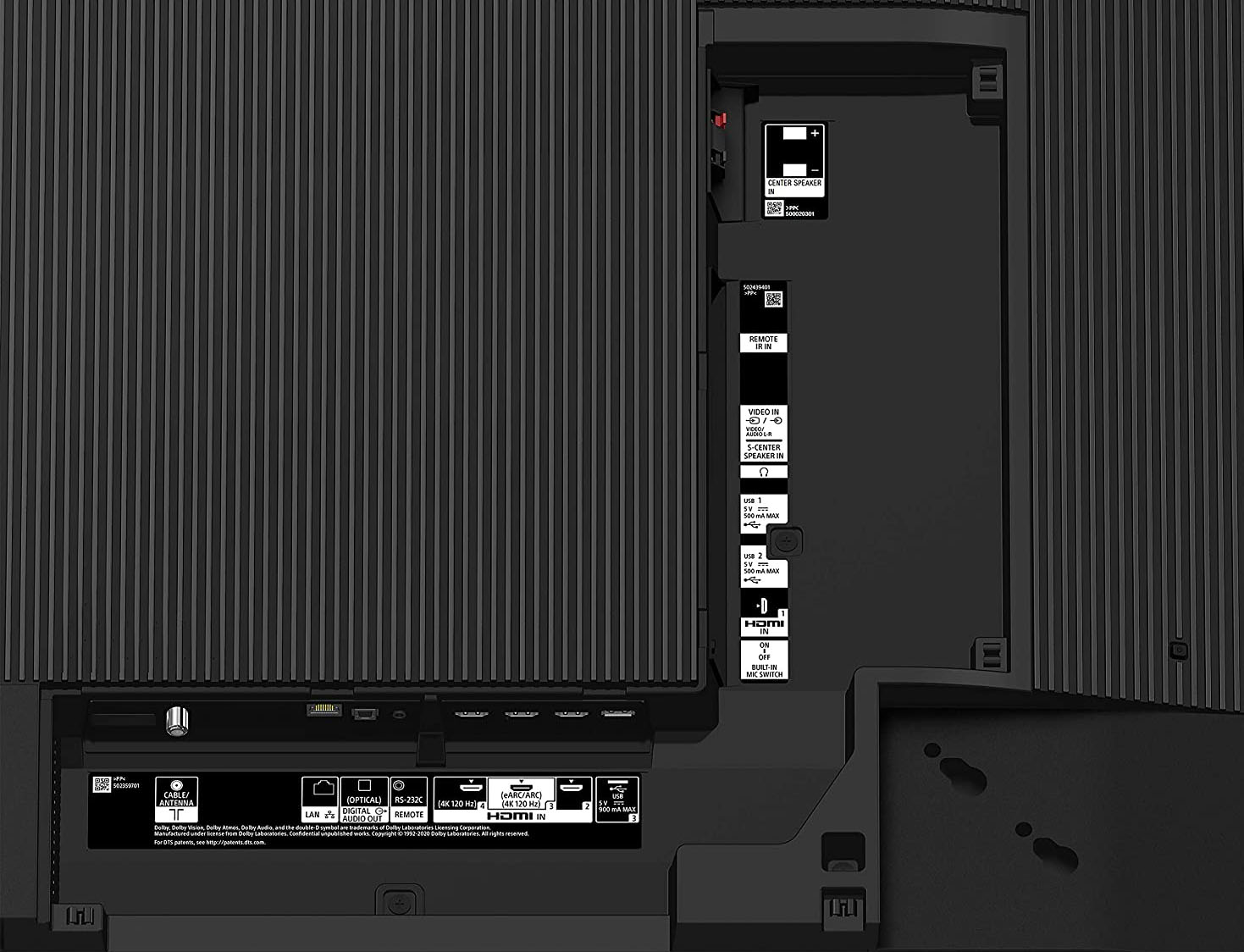
Ever since the first reviews started appearing I was determined to get the A90J. But when I saw its price I was very disappointed to be honest. I still want it but I will probably wait for Black Friday in case there will be some good offer for it. I am a bit worried about its motion performance. This is not the first time I hear about it as I saw a few youtube reviews also mentioning judder and stuttering. Is this very noticeable? I don’t want to pay so much money just to be frustrated by it.
Well, the thing is that the problem is there. How much it really depends on your eyes and the content itself. There are scenes where judder is very noticeable and others that is almost non detectable. If you are worried about it then your best bet would be to test it out in a local retailer an judge for yourself.
If you go OLED you never look back and since my first one being a LG C7 I never tried a LCD TV again. Now I am thinking to update and the A90J was in my radar for some time. The price is certainly a bit crazy but I saw it in a local store and surely looks amazing. Thanks you for your detailed review.
Hello there. As I wrote in my review it really depends on your budget. If you can afford it then there is nothing better out there. But if you are really thinking about its cost then the A90J is not exactly what I would call a value for money option. The A80J is better at this.